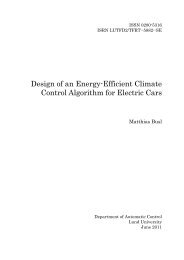Download full document - Automatic Control
Download full document - Automatic Control
Download full document - Automatic Control
Create successful ePaper yourself
Turn your PDF publications into a flip-book with our unique Google optimized e-Paper software.
Lund University<br />
Department of <strong>Automatic</strong> <strong>Control</strong><br />
Box 118<br />
SE-221 00 Lund Sweden<br />
Author(s)<br />
André Olsson<br />
Document name<br />
MASTER THESIS<br />
Date of issue<br />
February 2009<br />
Document Number<br />
ISRN LUTFD2/TFRT--5834--SE<br />
Supervisor<br />
Dr. Wolfgang Reinelt ELAU GmbH<br />
Prof. Anders Robertsson <strong>Automatic</strong> <strong>Control</strong>, Lund<br />
Prof. Rolf Johansson <strong>Automatic</strong> <strong>Control</strong> Lund (Examiner)<br />
Sponsoring organization<br />
Title and subtitle<br />
Modeling and control of a Delta-3 robot. (Modellering och kontroll utav en Delta-3 robot)<br />
Abstract<br />
This Master Thesis describes the mathematical modeling of a Delta-3 robot actuated by motors<br />
and drive units developed by ELAU GmbH. A given model of the ELAU GmbH drive unit and<br />
motor is used when building the Delta-3 robot model including three drive units, one for each<br />
motor to be able to actuate the three upper arms.<br />
The Delta-3 robot model is divided into kinematics and dynamics parts. The kinematics is used<br />
to calculate the trajectories for the three robot arms (joint space) and the corresponding motion<br />
of the robot travelling plate (Cartesian space). The Thesis also looks into the robot dynamics,<br />
so the coupling effect between the three arms is taken into account in the Simulink model.<br />
Different trajectories created with ELAU GmbHs own software are imported to Matlab<br />
workspace and simulated with the Simulink model. The results from the Simulink model are<br />
compared with the results from a real Delta-3 robot driven by ELAU GmbH hardware and<br />
software.<br />
The Jacobian matrix for the Delta-3 robot is also calculated to be used in the equations for the<br />
coupling effect between the three arms. The Jacobian matrix is also implemented in ELAU<br />
GmbH software to be able to calculate the joint velocity or joint acceleration when the TCP<br />
velocity or TCP acceleration is known and vice versa. These results can then be used in<br />
equations for calculating the torque which is needed for each of the three motors to actuate the<br />
upper arms along with the desired TCP trajectory. The torque calculations can be done offline<br />
so the real robot don’t have to be running, which gives the opportunity to see how much torque<br />
each motor needs so the robot is able to follow the desired trajectory for the robots travelling<br />
plate.<br />
Experiments with comparison between the Simulink model and the real robot are done and the<br />
results of the measured values are shown in the Thesis. Also the experiments for the<br />
implementation of the Jacobian matrix in ELAU GmbH software are shown in the Thesis.<br />
Keywords<br />
Classification system and/or index terms (if any)<br />
Supplementary bibliographical information<br />
ISSN and key title<br />
0280-5316<br />
Language<br />
English<br />
Security classification<br />
Number of pages<br />
71<br />
http://www.control.lth.se/publications/<br />
Recipient’s notes<br />
ISBN














